More than 1,000 climbers attempt an ascent of Mount McKinley each year, with a majority using the popular West Buttress route. During the main climbing season (May and June), hundreds of climbers funnel up and down the Kahiltna Glacier. To mitigate the impacts of climbers on the backcountry resources of Denali National Park and Preserve, the National Park Service limits the number of climbers each season (no more than 1,500) and establishes standards for human waste disposal.
Between 1951 and 2012, climbers have deposited at least 152,000 lbs (~70 metric tons) of human waste in the Kahiltna Glacier.
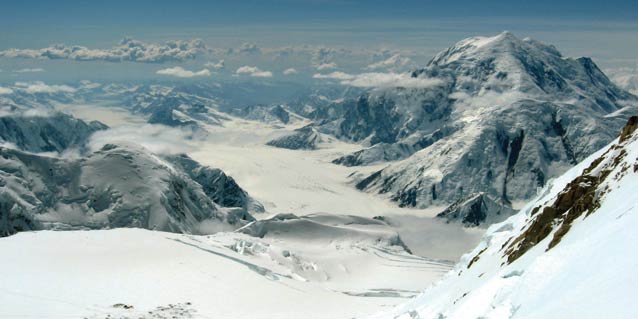
Michael Loso
Beginning in 2007, removal of human waste via Clean Mountain Cans (CMCs) became mandatory above the 14,200-foot Camp (4,300 m), as well as near the airstrip at Basecamp (7,200' or 2,200 m). Use of these CMCs, with biodegradable bag liners, has radically improved sanitation at the 17,200-foot High Camp (5,200 m). However, most bags of human waste collected in CMCs at all elevations—including at 14,200-foot Camp, where climbers spend the majority of their time acclimatizing and waiting for good weather—are thrown into crevasses between Basecamp and 14,200-foot Camp.
Tons of Human Waste Since 1951
Since Bradford Washburn’s first ascent of the West Buttress route in 1951, the number of climbers has increased from less than 500 per year prior to 1980 to about 1,200 per year. Climbing parties spend an average of 18 days on the mountain. The math is simple and impressive: depending on the average weight of each climber’s daily fecal output—between 0.23 and 0.35 lbs (106 and 159 g), more than 36,000 climbers have deposited between 152,000 and 215,000 lbs (69 and 97 metric tons) of human waste on the Kahiltna Glacier.
For now, the snowy surface of the Kahiltna Glacier remains fairly clean, because climbers follow NPS regulations and dispose of their human waste in CMCs and then in deep crevasses. But there is another factor at work—the glacier itself.
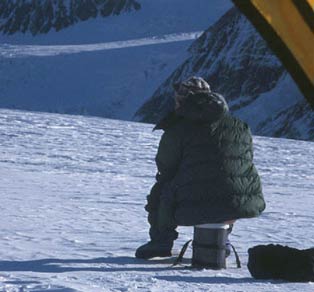
NPS Photo
Zones of Accumulation and Melting
Glaciers form in an accumulation zone where annual snowfall exceeds annual melt. The accumulated perennial snows eventually change to glacier ice and flow downhill until melt exceeds snowfall—at what is known as the ablation zone—at lower elevations.
Because the West Buttress climbing route is located in the accumulation zone of the Kahiltna Glacier, crevassed waste will be buried the next winter and ever more deeply each successive year. However, each year the glacier flows and slowly carries the waste downhill towards the ablation zone, where it will eventually, inevitably, melt out at the glacier surface. The precise timing of waste emergence depends on glacier velocity, on the rates of snow accumulation and melt—parameters that are difficult t o measure and sensitive to climate change—and on how far above the balance point between accumulation and ablation the waste was deposited.
What Happens to Crevassed Human Waste?
Recognizing that the Kahiltna Glacier is transporting human waste toward its eventual “melt out,” Dr. Michael Loso of Alaska Pacific University (APU), in collaboration with NPS climbing rangers and other physical scientists, began a multi-year study to answer two questions: (1) Where and when will the human waste emerge? and (2) Are there health impacts of the waste, i.e., are bacteria entering the meltwater?
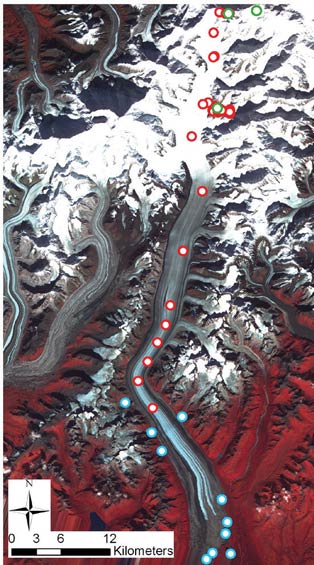
NPS Image
Research Approaches
To calculate the velocity of the Kahiltna Glacier (to predict how fast the waste is moving), Loso and his collaborators have used high-precision global positioning system (GPS) to track movements of over 30 stakes drilled into the ice, at intervals from the 11,200-foot Camp (3,400 m) down glacier about 33 miles (about 53 km)—see circles in graph at right. In addition, University of Alaska Fairbanks (UAF) collaborator Matthias Braun has measured velocities farther down glacier using repeat satellite images.
To gather more information about accumulation and melting of the Kahiltna Glacier, Loso is also working with UAF researcher Anthony Arendt and graduate student Joanna Young. By returning over one or more seasons to measure stakes inserted in the Kahiltna Glacier, they can quantify what is happening in both zones of accumulation (How much deeper are the stakes buried?) and of ablation (How much more of the stake is showing?)
To test for bacterial contamination from human waste, Alaska Pacific University graduate student Katelyn Goodwin analyzed meltwater collected from the Kahiltna River (where it flows out of the terminus of the Kahiltna Glacier about 70 km (43 miles) below the 11,200-foot Camp) and from nearby streams that would be unimpacted by the crevassed human waste. She also tested how the fecal coliform bacteria persistence in human waste might be affected by a variety of glacier microenvironments: (1) deep burial at Base Camp for one year, (2) exposure near the cold windswept summit for one year, (3) incidental contamination in “pee holes” near active climber camps during the climbing season, and (4) laboratory simulation of repetitive freeze-thaw cycles for over six months.
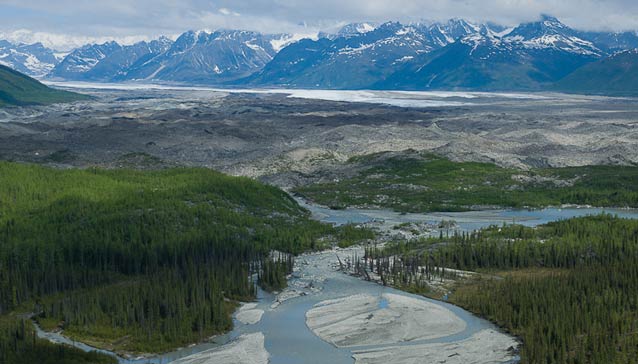
JT Thomas
When and Where Will the Waste Melt Out?
Ice on the Kahiltna Glacier is almost stationary in some locations, but “zips” along at more than 1,394 feet (425 meters) per year at a location about 14 miles (23 km) down from 11,200-foot Camp (see graph), and about 7 miles (12 km) below Basecamp. Although these rates may seem fast, it will take years for crevassed waste to reach the glacier’s ablation zone and melt out. Based on the preliminary information about accumulation and ablation, Loso’s estimate for where and when the first waste will emerge at the ice surface is near the Great Icefall about 9.3 miles (15 km) down glacier from Basecamp in the next decade.
Results: Bacteria and Human Waste
Tests of water taken from streams near the Kahiltna (unlikely to be impacted) came back clean (i.e., no coliform bacteria), but in both 2010 and 2011, trace levels of fecal contamination were found in the waters of the Kahiltna River—but at levels that are still within Alaska state water quality standards.
E. coli and other fecal bacteria were able to survive exposure to the cold and UV radiation in the four microenvironments tested. These findings strongly suggest that despite the massive size of the Kahiltna Glacier, human waste encased in the ice on the climbing route remains biologically active, interacts with glacial meltwater, and is already making its way into the downstream watershed.
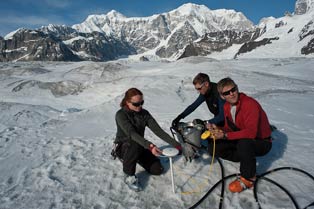
JT Thomas
What’s Next?
At the start of Loso’s study, the impacts of crevassed and emergent waste were unknown. Now estimates of the timing and location of the meltout of human waste are available. Fecal coliform is present in the glacier meltwater. A major remaining question concerns the aesthetic impact of emergent waste. Aside from human health concerns, what is the impact on visitor experience when waste piles begin melting out on the lower glacier?
Loso and collaborators will continue to work to understand the role of climate change in predictions of meltout times and locations, and to work with NPS rangers, researchers, and managers to consider the appropriate management response.
Last updated: January 31, 2025
